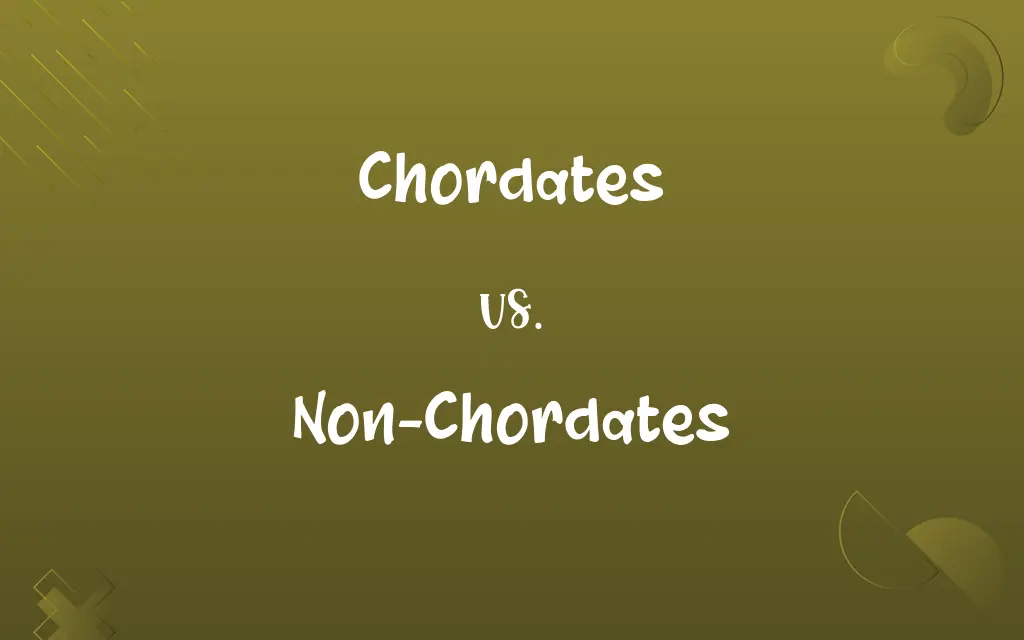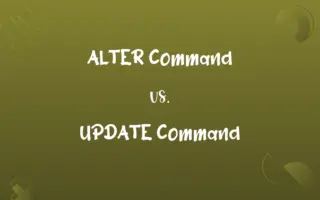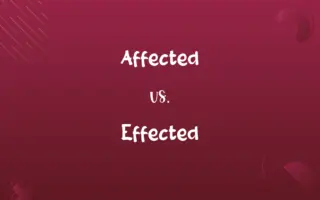Chordates vs. Non-Chordates: Know the Difference

By Shumaila Saeed || Published on February 20, 2024
Chordates possess a notochord, dorsal nerve cord, and pharyngeal slits at some stage; non-chordates lack these features.

Key Differences
Chordates are characterized by having a notochord, a dorsal hollow nerve cord, pharyngeal slits, and a post-anal tail at some stage in their life cycle. These features are fundamental to the group, which includes vertebrates like mammals, birds, and fish. In contrast, non-chordates do not possess these distinguishing characteristics and encompass a wide range of invertebrates such as insects, mollusks, and annelids.
Shumaila Saeed
Feb 20, 2024
In chordates, the notochord provides skeletal support, a feature that is fundamental during the embryonic development of all chordates. This notochord is replaced by a vertebral column in many adult chordates. Non-chordates, however, lack a notochord at any stage of their development. Their body support systems vary widely, ranging from exoskeletons in arthropods to hydrostatic skeletons in cnidarians.
Shumaila Saeed
Feb 20, 2024
The presence of a dorsal hollow nerve cord is another defining characteristic of chordates. This structure develops into the central nervous system: the brain and spinal cord in vertebrates. Non-chordates, on the other hand, have a solid nerve cord that is usually ventrally located. Their nervous systems are arranged differently and are not homologous with those of chordates.
Shumaila Saeed
Feb 20, 2024
Pharyngeal slits are present in chordates, primarily during embryonic development, and play various roles such as filter-feeding structures or developing into parts of the ear and neck. In non-chordates, similar structures may be absent or serve different functions not related to the chordate's pharyngeal slits.
Shumaila Saeed
Feb 20, 2024
Finally, chordates often have a post-anal tail, which is an extension of the body past the anal opening. Non-chordates might have tail-like structures, but these do not replicate the post-anal tail seen in chordates, as they often serve different purposes or are structured differently.
Shumaila Saeed
Feb 20, 2024
ADVERTISEMENT
Comparison Chart
ADVERTISEMENT
Chordates and Non-Chordates Definitions
Chordates
Chordates typically possess pharyngeal slits.
In fish, a type of chordate, pharyngeal slits evolve into gills.
Shumaila Saeed
Jan 13, 2024
Non-Chordates
Animals lacking a notochord at any stage.
Insects, as non-chordates, do not develop a notochord during their lifecycle.
Shumaila Saeed
Jan 13, 2024
Chordates
Animals with a notochord at some life stage.
Humans are chordates because they have a notochord during early development.
Shumaila Saeed
Jan 13, 2024
Non-Chordates
Non-chordates do not have pharyngeal slits.
Earthworms, being non-chordates, lack pharyngeal slits entirely.
Shumaila Saeed
Jan 13, 2024
Chordates
Organisms having a dorsal hollow nerve cord.
The spinal cord of a dog, as a chordate, is an example of a dorsal hollow nerve cord.
Shumaila Saeed
Jan 13, 2024
ADVERTISEMENT
Non-Chordates
Animals without a post-anal tail characteristic of chordates.
Jellyfish, as non-chordates, do not possess a post-anal tail.
Shumaila Saeed
Jan 13, 2024
Chordates
Chordates can be vertebrates or invertebrates.
Tunicates, despite being invertebrates, are chordates due to their larval stage features.
Shumaila Saeed
Jan 13, 2024
Non-Chordates
Organisms without a dorsal hollow nerve cord.
Snails, as non-chordates, have a more primitive nervous system compared to chordates.
Shumaila Saeed
Jan 13, 2024
Chordates
A group including animals with a post-anal tail.
A lizard, a chordate, has a distinct post-anal tail extending beyond its anus.
Shumaila Saeed
Jan 13, 2024
Non-Chordates
A diverse group including invertebrates without chordate-specific features.
Starfish, as non-chordates, lack the defining features of chordates such as a notochord.
Shumaila Saeed
Jan 13, 2024
Chordates
Any of numerous animals of the phylum Chordata, having at some stage of development a dorsal nerve cord, a notochord, and gill slits and including all vertebrates, the hagfishes, and certain marine animals such as the lancelets and the tunicates.
Shumaila Saeed
Jan 11, 2024
Repeatedly Asked Queries
What defines a chordate?
Presence of a notochord, dorsal hollow nerve cord, pharyngeal slits, and a post-anal tail at some life stage.
Shumaila Saeed
Feb 20, 2024
Do non-chordates have a backbone?
No, they lack a vertebral column, a characteristic of many chordates.
Shumaila Saeed
Feb 20, 2024
Are humans chordates?
Yes, humans are chordates with all defining features present during development.
Shumaila Saeed
Feb 20, 2024
Can non-chordates have a nervous system?
Yes, but it's different from the dorsal hollow nerve cord of chordates.
Shumaila Saeed
Feb 20, 2024
Are all chordates vertebrates?
No, some like tunicates and lancelets are invertebrates.
Shumaila Saeed
Feb 20, 2024
Do all chordates live in water?
No, chordates inhabit diverse environments, including land and air.
Shumaila Saeed
Feb 20, 2024
Do chordates always have pharyngeal slits?
They have them at some developmental stage, but these may not be present in adults.
Shumaila Saeed
Feb 20, 2024
Is the notochord the same as a backbone?
No, the notochord is a flexible rod, which in vertebrates is often replaced by the backbone.
Shumaila Saeed
Feb 20, 2024
Can non-chordates be larger than chordates?
Yes, some non-chordates like giant squids can be very large.
Shumaila Saeed
Feb 20, 2024
Do non-chordates have a role in ecosystems?
Yes, they play crucial roles in various ecosystems.
Shumaila Saeed
Feb 20, 2024
Do chordates all have similar reproductive systems?
No, their reproductive systems can vary widely.
Shumaila Saeed
Feb 20, 2024
Can chordates be found in every habitat?
Chordates are found in most habitats, but not in every single one.
Shumaila Saeed
Feb 20, 2024
Are non-chordates less complex than chordates?
Not necessarily, they can be complex in different ways.
Shumaila Saeed
Feb 20, 2024
Are all chordates mobile?
Most are, but some, like certain tunicates, are sessile as adults.
Shumaila Saeed
Feb 20, 2024
What are examples of non-chordates?
Examples include insects, mollusks, and annelids.
Shumaila Saeed
Feb 20, 2024
Are chordates always larger than non-chordates?
No, size varies greatly within both groups.
Shumaila Saeed
Feb 20, 2024
Do non-chordates have a heart?
Some do, but their circulatory systems can be quite different from those of chordates.
Shumaila Saeed
Feb 20, 2024
Are all chordates equally advanced?
"Advanced" is subjective, but there's a wide range of complexity within chordates.
Shumaila Saeed
Feb 20, 2024
Is the classification of chordates and non-chordates static?
No, as scientific understanding evolves, classifications can be re-evaluated and adjusted.
Shumaila Saeed
Feb 20, 2024
Share this page
Link for your blog / website
HTML
Link to share via messenger
About Author
Written by
Shumaila SaeedShumaila Saeed, an expert content creator with 6 years of experience, specializes in distilling complex topics into easily digestible comparisons, shining a light on the nuances that both inform and educate readers with clarity and accuracy.









































































